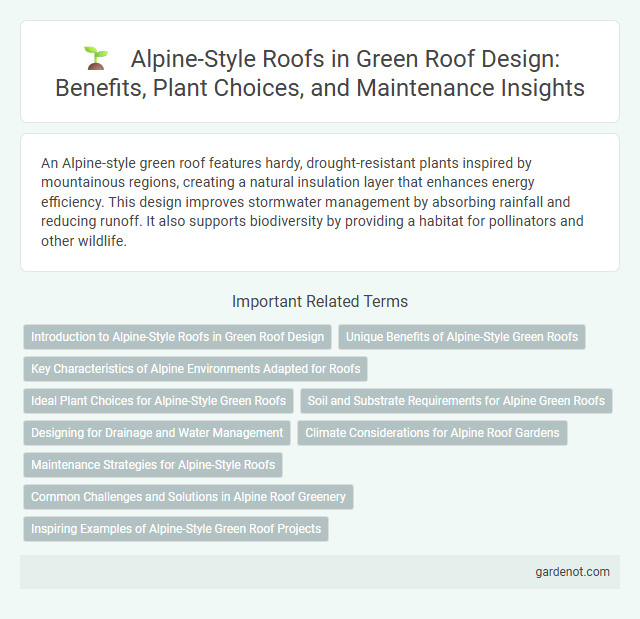An Alpine-style green roof features hardy, drought-resistant plants inspired by mountainous regions, creating a natural insulation layer that enhances energy efficiency. This design improves stormwater management by absorbing rainfall and reducing runoff. It also supports biodiversity by providing a habitat for pollinators and other wildlife.
Introduction to Alpine-Style Roofs in Green Roof Design
Alpine-style roofs in green roof design feature steep slopes that facilitate efficient water drainage and mimic the natural mountainous terrain, promoting biodiversity and resilience in harsh climates. These roofs utilize hardy alpine plants adapted to cold, windy conditions, ensuring year-round green coverage and reducing soil erosion. Implementing alpine-style roofs contributes to sustainable urban environments by enhancing insulation and supporting native ecosystems.
Unique Benefits of Alpine-Style Green Roofs
Alpine-style green roofs provide exceptional insulation, mimicking natural mountain ecosystems to enhance energy efficiency and reduce urban heat. Their resilient, drought-tolerant plant species increase roof longevity while supporting local biodiversity, especially in challenging climates. These roofs also optimize stormwater management by absorbing heavy precipitation, minimizing runoff and protecting urban infrastructure.
Key Characteristics of Alpine Environments Adapted for Roofs
Alpine-style green roofs are characterized by steep slopes, high drainage capacity, and drought-resistant vegetation adapted to harsh mountain climates. These roofs use native alpine plants such as sedums, mosses, and grasses that thrive in low-nutrient, cold, and windy conditions. The design emphasizes thermal insulation, water retention, and resilience against extreme weather typical of high-altitude environments.
Ideal Plant Choices for Alpine-Style Green Roofs
Ideal plant choices for alpine-style green roofs include hardy, drought-tolerant species such as sedum, sempervivum, and alpine grasses that thrive in well-drained, shallow substrates. These plants exhibit excellent cold resistance and low maintenance requirements, making them suitable for the harsh, high-altitude exposure typical of alpine environments. Incorporating native alpine wildflowers enhances biodiversity and promotes ecological balance while ensuring the roof system's long-term resilience and aesthetic appeal.
Soil and Substrate Requirements for Alpine Green Roofs
Alpine-style green roofs require specialized soil and substrate compositions that mimic high-altitude alpine environments, ensuring optimal drainage and nutrient retention. These substrates typically consist of lightweight, mineral-rich materials with low organic content to support drought-tolerant alpine vegetation while preventing waterlogging. Properly balanced substrate depth and texture are crucial to sustain root systems and promote plant health under harsh climatic conditions characteristic of alpine regions.
Designing for Drainage and Water Management
Alpine-style green roofs require precise drainage planning to handle heavy snowmelt and rapid water runoff effectively. Incorporating layered substrates with high permeability and integrated drainage mats ensures optimal water retention and prevents root saturation. Strategic placement of drainage outlets and channels supports efficient water management, reducing structural strain and promoting plant health.
Climate Considerations for Alpine Roof Gardens
Alpine-style green roofs are designed to withstand extreme temperature variations and high-altitude weather conditions typical of mountainous regions. These roofs incorporate hardy, drought-resistant alpine plants that thrive in poor soil and can survive heavy snowfall and strong winds. Proper drainage and insulation are critical to prevent root damage and ensure plant survival through harsh winter freezes and intense summer sun exposure.
Maintenance Strategies for Alpine-Style Roofs
Alpine-style green roofs require specialized maintenance strategies focused on preserving their unique vegetation and structural integrity in harsh mountain climates. Key practices include regular inspection of drainage systems to prevent water retention issues, selective pruning to maintain plant health, and timely removal of invasive species. Implementing seasonal adjustments, such as winter protection measures and spring rejuvenation treatments, ensures long-term durability and ecological balance on alpine rooftops.
Common Challenges and Solutions in Alpine Roof Greenery
Alpine-style green roofs commonly face challenges such as extreme temperature fluctuations, strong winds, and limited soil depth, which can stress vegetation and hinder plant growth. Solutions include selecting cold-hardy, drought-resistant plant species like sedums and alpine grasses, installing deeper growing mediums with adequate drainage, and using windbreaks or protective barriers to minimize exposure. Proper irrigation systems and regular maintenance also enhance resilience, ensuring sustainable alpine roof greenery despite harsh environmental conditions.
Inspiring Examples of Alpine-Style Green Roof Projects
Alpine-style green roofs showcase innovative integration of native high-altitude plants such as sedum, alpine grasses, and wildflowers, enhancing biodiversity while providing excellent insulation and stormwater management. Notable projects include the Swiss Alpine Museum roof in Bern, which combines traditional sloped roofing with a thriving green ecosystem that mimics the natural alpine environment. These roofs demonstrate sustainable design by reducing urban heat island effects and promoting habitat connectivity in mountainous urban areas.
Alpine-style roof Infographic

 gardenot.com
gardenot.com